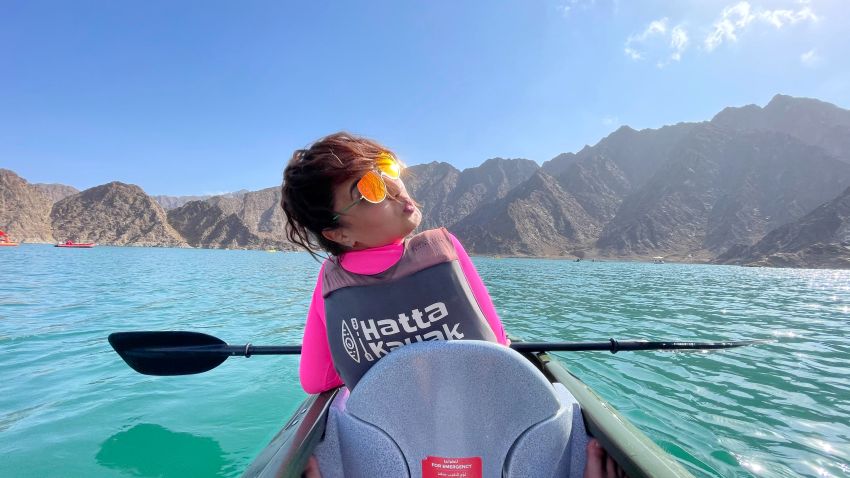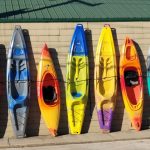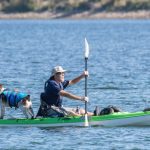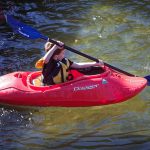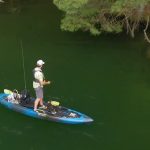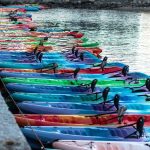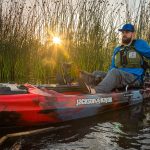This is our list of industry-leading kayak companies in the US. We also have detailed reviews of most brands and their model lines.
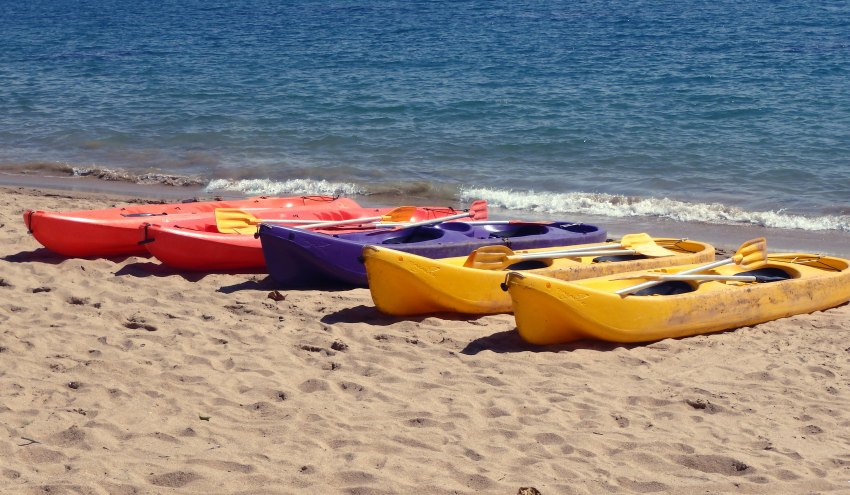
Buying your first kayak can be quite the fraught experience—there are just so many different models to choose from!
For some people, it’s easy to decide what type of kayak suits their needs best. They’re anglers, hunters, or adventure paddlers on the prowl for a very specific type of kayak, so it narrows down their options significantly.
But for many, those of us who like to use kayaks for recreation as well as adventure, it’s tough to know which kayak will suit us best.
Do we want inflatable or hard-shell? Sit-on or sit-in? Rotomolded plastic or fiberglass? 10-foot, 12-foot, or 16-foot?
You see what I mean? There are just too many choices, so it makes the whole buying process tough.
Don’t worry, I’ve got your back.
In this article, we’re going to start off with the simplest, most basic choice: whether to choose a sit-in kayak or sit-on-top kayak. This difference will determine what you can use your kayak for, how stable is, what kind of storage it has available, and many more factors.
It’s actually a much simpler choice than you realize—you just have to go through a long list of the differences in order to boil it down to the elements that are most crucial for your paddling.
The article is a bit on the longer side (we’ve got to explain everything), but trust me, if you stick with it and read all the way to the end, I guarantee you’ll walk away knowing exactly what kayak to buy.
(Just in case you’re too busy: I’ve added a clear “Winner” in each section so you can see which kayak is better at a glance.)
Sit-inside vs. Sit-on-top kayaks: The Big Differences
Design
The design of the kayak is probably the greatest fundamental distinction between the sit-in and sit-on-top kayak, so that’s the best place to start.
Sit-in kayaks feature higher sidewalls and an enclosed cockpit (the place where you sit). Because you’re sitting “inside” the kayak, you’re actually lower—either on or beneath the water’s surface. This creates a lower center of gravity and contributes to greater secondary stability (we’ll explain more in the “Stability” section). Sit-in kayaks also tend to have more rounded and V-shaped hulls, which slice through the water more effectively. They are also typically narrower.
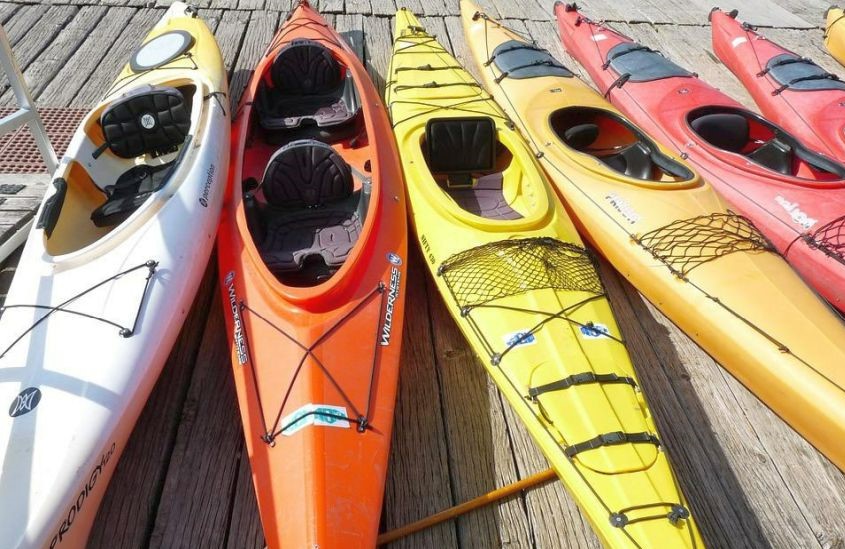
Sit-on-top kayaks have an open-cockpit design, with the seat mounted on top of the kayak. You’re on top of the kayak and elevated a few inches above the water’s surface, which contributes to higher primary stability (again, an explanation is coming in the “Stability” section below). Sit-on-top kayaks will feature a rounded or V-shaped hull like sit-in kayaks, but the angle will be shallower and the kayak body wider because they’re designed to float on top of the water (kind of like a paddleboard) rather than cut through it.
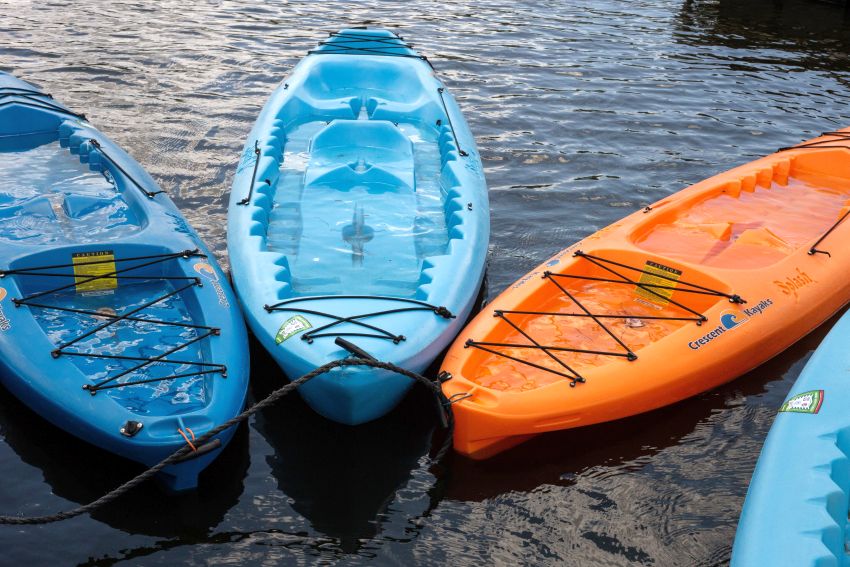
As you’ll see in the many sections, these design differences will lead to some pretty important distinctions between the two types of kayaks.
Winner: Too soon to declare! (Also, both designs are incredibly functional in their own right, so neither is the clear “winner” overall—it’s all about choosing the design that suits your needs best, as you’ll see below.)
Weight/Load Capacity
As a big, heavy guy (6’6’, clocking in around 240 lbs.), this was actually one of the first factors I had to consider when buying my kayak. A lot of kayaks have lower weight capacity, a fact I didn’t know when I borrowed a lightweight 10-footer (Pelican Summit 100X) from a friend. Turns out I was too heavy, which led to some very annoying experiences with sinking/capsizing.
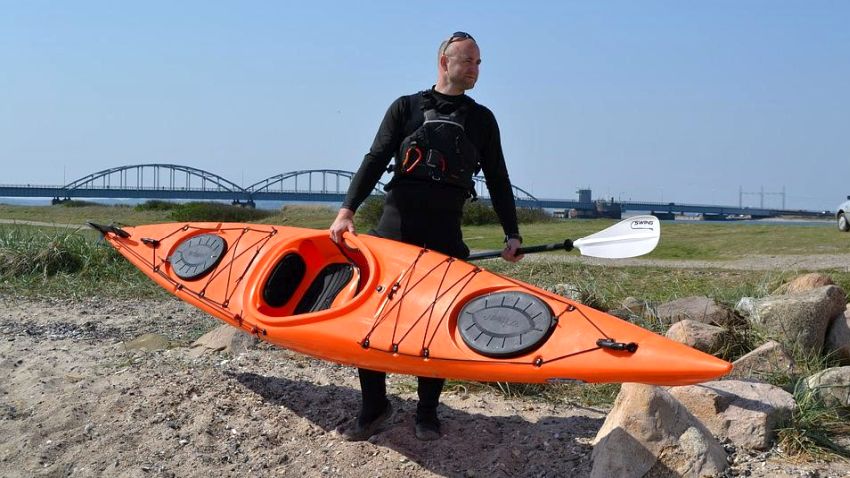
Thankfully, I did some more research, and that led me to discovering that not all kayaks have the same weight capacity. Not only do larger (longer) kayaks have a higher capacity, but so do the different types of kayaks.
You see, when you’re riding in a sit-in kayak, you’re already pretty low in the water (because of the kayak’s design), so adding a lot of weight will make your craft sink deeper and deeper until either you’re below the water line or you’re so heavy you rock with every wave and current and ultimately tip over.
Typically, sit-in kayaks will have a lower weight capacity—the max tends to be around 300 pounds. That means 300 pounds between the paddler, PFD, paddle, and all the equipment you’re lugging around. Not exactly ideal if you’re a heavy person planning to take a lot of gear camping, right?
With sit-on kayaks, however, the wider body, the built-in bulkheads (compartments that trap air inside the hull to add buoyancy), and the elevated position above the water line means your kayak can typically carry more gear. The weight capacity can be as much as 350 to 400 lbs., meaning you can pack a lot more equipment.
Winner: Sit-on-top kayaks, by a margin of 50 to 100 lbs. That’s quite a lot if you need to haul more gear around!
Climbing In
I’m not going to tell you the hilarious story of how many times I face-planted in the lake the first few times I tried to climb into my kayak, but suffice it to say, it was not a pretty sight.
The issue, I found, is that the kayak I was using (which happened to be a sit-in type), would rock a lot when I put my weight on it. Unless I placed my loading foot exactly in the center of the cockpit, my weight would cause the kayak to tip to the side, and I ended up in the water.
(Don’t worry: it’s not too tough to master. It just takes some practice to get it right!)
Then came the day that I climbed onto my first sit-on-top kayak. Notice I didn’t say “tried to climb”—that’s how easy it was the first time!
As you’ll see in the next section on “Stability”, sit-on-top kayaks have significantly greater primary stability, which keeps them very stable when you’re mounting them. You can get on and off with minimal effort and very little risk of tipping over, making them much more user-friendly for beginners.
There’s also no struggle to slide your legs into the cockpit, or slide them out when you’re trying to dismount. With a sit-on-top kayak, you just hop on easily, settle in, and get paddling.
Winner: Sit-on-top kayaks, by a long mile. It’s a beginner-friendly, no-hassle mounting process, and they’re much harder to tip over even if you have poor balance when trying to climb up.
Stability
Before we get into talking about the differences in stability between the two kayak types, I need to explain about “primary” and “secondary” stability.
We actually have a whole post about kayak stability if you want to explore it further.
Primary stability refers to how stable the kayak is when “at rest” (i.e. on flat, calm water). Typically, wide vessels with flat bottoms tend to have much higher primary stability because there is a greater surface in contact with the water, which is much harder to imbalance or tip.
Secondary stability refers to how stable the kayak is when leaning on its side (i.e. tipping over in choppy waters). Typically, narrower vessels with deeper hulls (round or V-shaped) will have much higher secondary stability because their center of gravity is lower (below the water’s surface) and the hull allows the boat to rock back and forth.
What you need to know is that you cannot have both high primary and secondary stability. To have more of one will reduce the other. That means a kayak that is very stable on flat water will be more likely to capsize in choppy water, while a kayak that can handle the ups and downs of choppy water will feel more wobbly and unstable on calm, flat water.
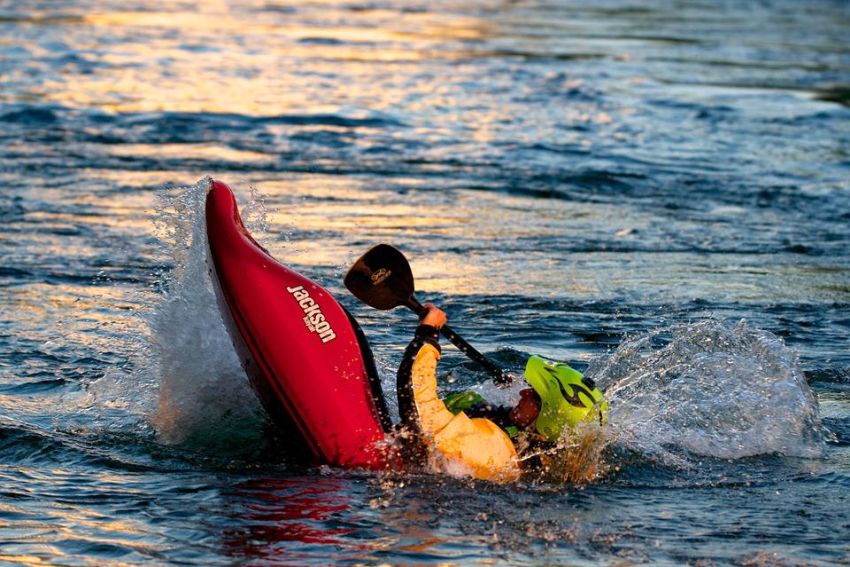
Got it? Good! Now to see how that applies to you.
Sit-on kayaks tend to be larger, wider, and heavier, with the shallow, flat (or flatter) hull that contributes to high primary stability. If you’re paddling on a placid lake, slow-moving river, or calm ocean, a sit-on-kayak will be your best choice. You’ll basically never fall into the water because of its excellent primary stability.
Sit-in-kayaks tend to be narrower, with a sharper hull angle and lower center of gravity. This contributes to higher secondary stability, meaning they’ll handle choppy, turbulent waters LIKE A BOSS. (You’ll notice how most whitewater and ocean expedition kayaks are sit-in for this exact reason!).
You won’t be as stable on calm days, but you can trust that if the wind ever kicks up or the current gets fast, your kayak can handle it.
Winner: Sit-in kayaks for higher secondary stability on rough waters, sit-on-top kayaks for higher primary stability on calm, flat waters.
Mobility
If you’re anything like me, you need to move around a bit when kayaking. And I’m not just talking about swinging your arms as you paddle—you’ve got to shift positions, reach for your gear, grab a bottle of water, and so on.
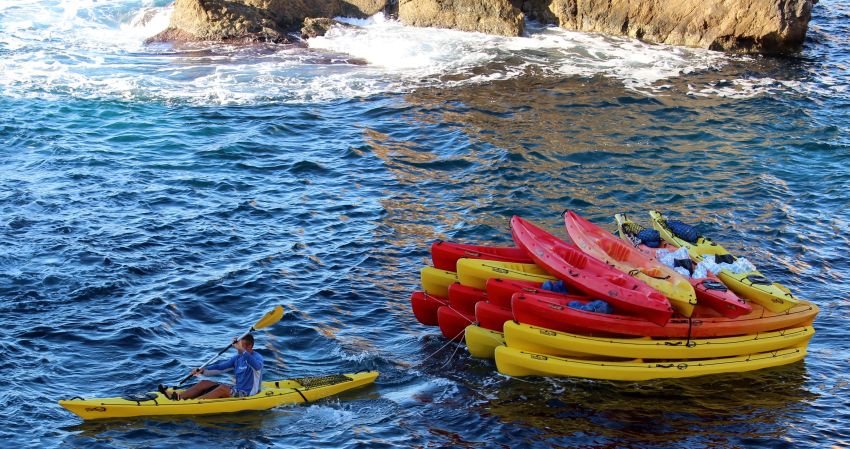
With a sit-in kayak, you’re stuck inside the enclosed cockpit, so there’s not a lot of room to move. It’s tough to shift to reach around behind you, and anything that’s out of your immediate arm’s reach will stay that way until you can make landfall or climb out of your kayak.
With a sit-on-top kayak, however, the higher primary stability means you’ve got a platform that you can shift and move around on (provided the water is calm). You can climb out of your seat, turn to grab something from behind you, lie down flat to aim your rifle, or even stand up to really put some oomph into that fly-fishing cast.
This is why so many anglers and hunters opt for the sit-on-top kayak.
Winner: Sit-on-top kayaks, by a landslide. You can move easily and shift positions with little risk of tipping over.
Weather
When the days are sunny and the water is warm, no one gives a second though to which kayak type will be better for their weather conditions. You just sit back and enjoy every moment you spend paddling, loving the spray on your face, the sun shining down on you, and the wind blowing in your hair.
(Sounds pretty awesome, doesn’t it?)
But as much as we wish it were so, it can’t be summer all year around. There will be days when the rain starts falling, the wind turns cold, the sun is gone, and the water temperature plummets. On these days, you’ll definitely be wondering if you’ve chosen the right kayak for your cool or cold-weather paddling trips.
With a sit-on-top kayak, you are fully exposed to the elements. The open-cockpit (no-cockpit, really) design means every gust of wind and splash of water will hit you full-on. You can bundle up in waterproof clothing (boots, pants, shirt, gloves, hat, jacket, etc.), but that’s all the protection you’re going to get.
A sit-in kayak, on the other hand, uses the closed-cockpit design, which means you’ve got the kayak itself as primary protection against the wind and water. If you really want to step up your protection, you can even add a spray skirt to keep water from getting inside your kayak.
Sit-in kayaks are much better for the days when the weather gets cold, windy, rainy, or (if you’re a madperson like some of the paddlers I’ve encountered here in Canada) snowy.
Winner: Sit-in kayaks just offer better protection against wet and cold weather, shielding you from the worst of it.
Speed and Performance
When it comes to speed and performance, design makes a huge difference!
Sit-on-top kayaks are wider and shallower-draft, so they don’t sit as low in the water. This makes for high primary stability but doesn’t really contribute to speed. The fact that they’re typically heavier than sit-in kayaks also makes it harder for you to pick up or maintain high paddling speeds.
Sit-in kayaks are narrower, sit low in the water, and have a hull shaped to slice through the water. No surprise, then, that they’re the faster choice. The design features that provide high secondary stability play a role in speed and performance.
Winner: Sit-in kayaks, by a healthy margin. It’s all in their speed-oriented design!
Tracking and Maneuverability
Tracking refers to the kayak’s ability to cut through the water in as straight a line as possible. A kayak with “good” tracking will continue forward even after you stop paddling.
Maneuverability refers to the kayak’s ability to turn to the right or left (or, to use nautical terms, starboard or port-side), as well as how efficiently the kayak responds to your paddling strokes.
What’s interesting is that (like primary/secondary stability) kayaks that track well are often less maneuverable, and kayaks with high maneuverability often track poorly. This is due to the design differences: short, flat-bottomed kayaks maneuver best, while longer kayaks with sharper-edged hulls track better.
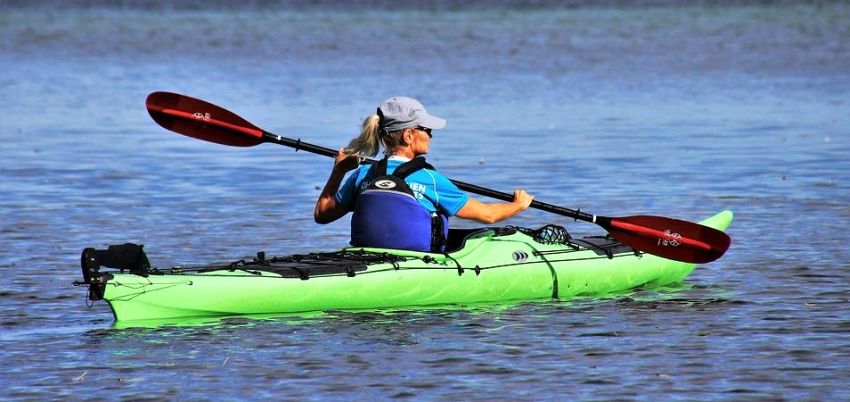
In terms of sit-in vs. sit-on-top kayaks, you’ll find that sit-in kayaks tend to track better, slicing through the water with ease. Interestingly enough, sit-inside kayaks also maneuver better. They make sharper, tighter turns with less effort than goes into turning/steering a sit-on-top kayak.
Winner: Sit-in kayaks take the lead in both tracking and maneuverability.
Bracing
Bracing is a practice of pushing your feet against the pedals and your legs/knees against the inside of the kayak’s hull/cockpit in order to give your lower body more stability and power to drive into your paddling stroke. When you want to pick up speed or make sharp, quick turns, bracing makes a huge difference in your paddling performance!
Pretty easy to see which is the clear winner here, isn’t it? With sit-on-top kayaks, there’s nothing you can push your legs against—just your feet against the pedals and your back against the seat. Sit-in kayaks have that enclosed cockpit and higher sidewalls that allows you to brace for more power. Many performance models also feature thigh braces for even better connection to the boat. It feels more like wearing your kayak that just sitting inside.
Winner: Sit-in kayaks, every time. The enclosed cockpit gives you a solid object to brace against.
Comfort
There are very few things worse for kayakers than the “dead leg” feeling. You can feel the tingle running all the way down to your feet, then slowly they lose sensation until they’re numb. Annoying as heck, right?
The problem here is that the kayak seat presses against the sciatic nerves in the backs of our legs. The longer the pressure persists, the more you lose sensation in the leg (a temporary issue, I promise!).
The best thing to do to combat this sensation is to adjust the angle of the seat bottom so that your butt is higher than your legs. But shifting your position frequently can also help to reduce the pressure on your sciatic nerve.
In a sit-in kayak, it’s pretty much impossible to stretch out your legs or shift position significantly. You’re enclosed in the cockpit and going nowhere.
Sit-on-top kayaks, on the other hand, give you plenty of room to move around, shift your legs, even hang them off the side of the kayak—anything to get rid of the dead leg feeling.
Sit-on-top kayaks are also more spacious and give you more space to stretch out in. You’ll feel less “trapped”, especially if you’re a big paddler like me.
Winner: Sit-on-top kayaks take the cake for comfort; they’re built to be more spacious and give you plenty of room to lounge and stretch out.
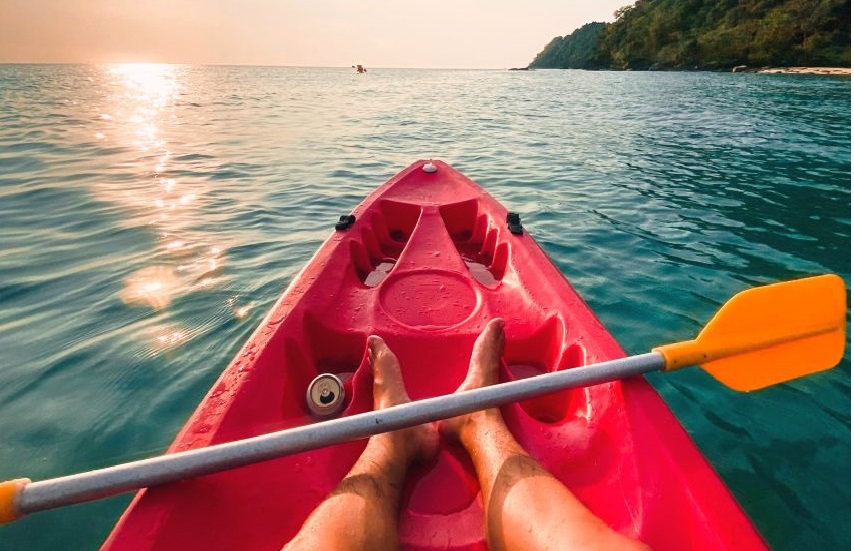
Bailing
One of the great things about sit-in kayaks is (as we saw in the “Weather” section) that they typically don’t get wet. Sure, you bring a bit of water in you when you climb in, and some will splash/spray/slosh over the sides if paddling conditions are choppy or windy, but for the most part, the cockpit of the sit-in kayak will stay fairly dry. Especially if you use a spray skirt!
However, if the cockpit does fill with water—for example, if choppy waters splash over the gunwhales and into the kayak, or if you capsize and the kayak flips over—then it’s a LOT of work to get the water out (technically called “bailing”).
To bail a sit-in kayak, you need a special bilge pump—like this one by Perception—and it takes a good few minutes to get all the water out. If you don’t have a pump, you can use the trusty bucket method. Ultimately, however, there’s still going to be enough water inside the cockpit that paddling back to shore is going to be a hassle-and-a-half!
Sit-on-top kayaks, on the other hand, are self-bailing. What that means is they have special drainage holes built into their hull. When they get wet, even if they capsize, the water just drains right out those holes in seconds. Because there’s no cockpit to fill, there is no need to spend time and effort bailing out the boat.
Winner: Sit-on-top kayaks are designed to be self-bailing and make getting rid of water exponentially easier.
Self-Rescue/Remount
Let’s be honest: even the best kayaker will sometimes end up in the water.
For example, you went out paddling first thing in the morning when the weather was clear, only to find yourself caught in a storm on your way back to shore. Choppy water + high winds + heavy rains = higher chance of capsizing. Or maybe you started off paddling down a slow-moving river, only to find out that the current flows faster and takes some sharp turns.
If you end up in the water, you can always climb back onto your kayak. Sit-on-top kayaks are easy to flip back over and climb on top of because of their design. They don’t have a cockpit, but the body is made up of individual bulkheads that hold air and add buoyancy. It’s a cinch to right the kayak and haul yourself back on top.
Sit-in kayaks, on the other hand, make self-rescuing and remounting a lot more difficult. There are all kinds of techniques for righting a capsized kayak, climbing back aboard, and bailing it out (such as the one taught in this video from REI), but even still, it’s a lot of time and effort going into self-rescue.
Winner: Sit-on-top kayaks are the clear winner by a large margin, because they’re so easy to right and remount—it literally takes seconds, and no bailing needed!
Gear Storage
A lot of casual paddlers don’t have to worry about gear. They’ve just got a few items in their dry bag (for example, I like to bring my phone, waterproof headphones to listen to music, keys, wallet, and other items I don’t want to leave unattended on the shore while I’m taking a paddle around the lake) and maybe a bottle of water and a couple of snacks.
For this amount of gear, you don’t really need much storage space.
But what if you’re planning a multi-day paddling trip upriver? Or if you’re using your kayak to haul your camping equipment up/downriver, across a lake, or out to a secluded island for a private campsite? That’s a different story altogether!
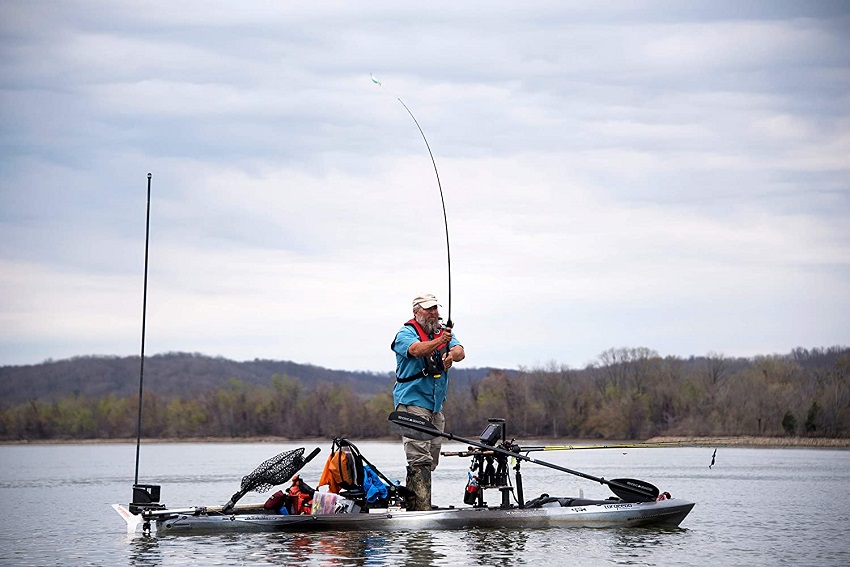
We’ve already seen that sit-on-top kayaks have a higher weight capacity, which means they’ll allow you to carry more gear overall. Many will come with hatches that are (mostly) waterproof, or offer in-hull storage so you can store your gear (even long items, like fishing rods) inside the hull of the kayak (how cool is that?)
However, some sit-on-top kayaks don’t have compartments, so you’ll have to strap all your gear to the deck (using webbing, carabiners, straps, etc.). All of the gear will be directly exposed to water and the sun, which could be less-than-ideal for items you’d rather keep dry (such as foodstuffs, electronics, etc.).
On the other hand, sit-in kayaks typically feature one or two waterproof storage compartments. These come with lids that you can close, protecting your gear from water (except for maybe the occasional drip). Sadly, you can’t carry as much gear on a sit-in kayak.
Winner: Sit-in kayaks protect your gear, even though their lower weight capacity means the amount of gear you can carry/store is limited. However, sit-on-top kayaks that come with built-in hatches or storage compartments can carry more weight and offer the same protection for your gear.
Gear Accessibility
Remember how I just mentioned the waterproof storage compartments that most sit-in kayaks come with? While this is great for keeping your gear dry, it makes all that gear a bit inaccessible. It’s tough to twist in your seat, wrestle open the waterproof lid, and fumble around inside the storage compartment to get at your gear.
With a sit-on-top kayak, you’ve got everything within easy reach. In addition to the storage compartments (on the models that have them), there are also plenty of niches and nooks where you can place your tackle box, lunch box, dry bag, etc. You can usually install mounts for your fishing rods, paddle holders, and other add-ons that provide convenient places to store your gear. It won’t be as protected as in a sit-in kayak, but it will all be easily accessible.
Winner: Sit-on-top kayaks tend to keep everything in arm’s reach, and you can even stand up/move around/shift position to get at items you can’t reach when sitting down.
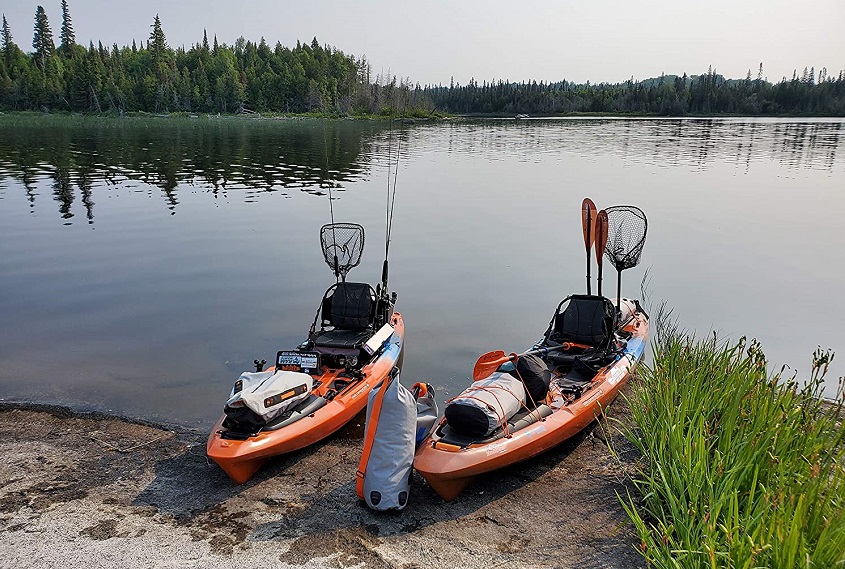
Sun Protection
For those of us with fair skin who tend to be prone to sun-burning, the need to protect ourselves from the sun is a concern that plagues us all summer long. (I go through a few bottles of sunscreen each season!)
On those hours-long, all-day, or even multi-day paddling trips, the sun can actually be one of the greatest dangers we face. There’s the risk of heat stroke, dehydration, and painful sunburns, but it’s the longer-term issues of skin cancer (melanoma) that are of greatest concern.
In both types of kayaks, you’ve got to worry about your face, neck, and arms when paddling. Even if you’re wearing PFD and a shirt, you’re not fully protected.
In a sit-on-top kayak, you’re fully exposed to the sun. If you wear shorts and paddle barefoot, your entire lower body is unprotected.
However, thanks to the enclosed design, a sit-in kayak will be more effective at protecting your lower body and feet from the sun. The cockpit may get a bit hot when the sun is shining full on, but it’s an acceptable trade-off if it means you’re protected from sunburns and solar radiation.
Winner: The design of a sit-in kayak precludes you from having to worry about UV radiation on your legs, though you’ll still need to wear proper upper body protection (including a hat, sunglasses, long-sleeved shirt, PFD, and plenty of sunscreen).
Pets and Kids
If you’re a parent (like me), one of your greatest joys in life is being able to share your hobbies and interests with your kids. Taking my sons and daughters kayaking is the highlight of my summer.
Though they’re young adults now, I loved taking them paddling in my kayak when they were younger (and smaller/lighter). They got to sit back, relax, and enjoy the wind and waves, while I paddled us around the lake, beach, or river.
In a sit-in kayak, that’s just not possible. The enclosed cockpit has just space enough for one paddler, so there’s nowhere for kids to sit. (Trying to paddle a tandem kayak solo is a NO-GO!)
With a sit-on-top kayak, however, there’s plenty of space for your (small) kids to sit. They can ride behind you or on the front of the kayak (depending on the kayak’s design/length/seat placement). Not only that, but if they want to jump into the water, it’s easy for them to remount the kayak afterward.
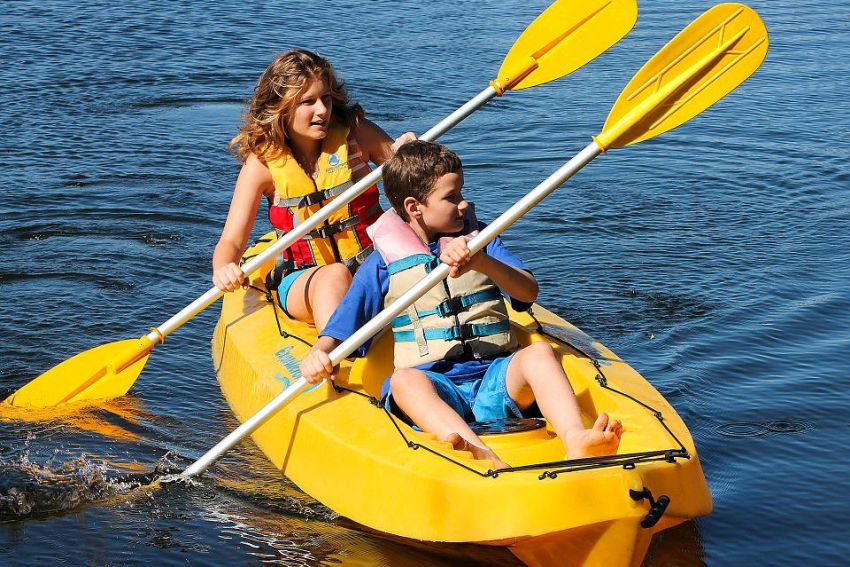
For pet owners who want to take their dog on a kayaking trip, the same holds true. Sit-on-top kayaks just have more room to sit and move around on, and they’re far more stable when your pet wants to jump into the water or climb back on board.

Winner: Thanks to the open design, sit-on-top kayaks are better-suited to taking your kids and pets paddling with you.
Paddle Length and Weight
One thing I’ve discovered when switching between the two types of kayaks is that sit-on-top kayaks use a longer paddle than sit-in kayaks. Because you’re sitting on top of the kayak and well above the water line, there is a greater distance between you and the surface, so the paddle has to be longer in order to dip into the water and properly paddle.
And you know what a longer paddle means: a heavier paddle.
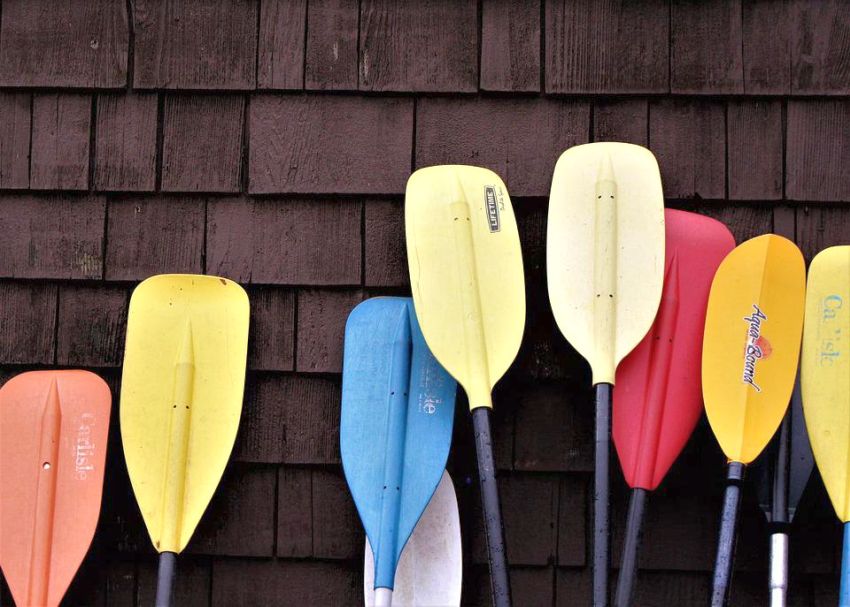
It’s not immediately noticeable, but after 4+ hours of paddling, the weight difference will definitely tire you out significantly more.
Winner: Sit-in kayaks use lighter, shorter paddles, so there’s less weight to worry about over the hours of paddling.
Activity
As you’ve probably seen by now, the two types of kayaks are significantly different—neither “better” than the other, but better-suited to certain activities.
Sit-in kayaks tend to be used for distance paddling due to their faster speed and better tracking and steering (see the next two sections). Thanks to their high secondary stability, they’re also utilized for whitewater paddling, river travel, and ocean voyages. They can handle fast currents and high waves with ease.
Sit-on-top kayaks, on the other hand, tend to be used for more recreational pastimes (such as snorkeling or swimming), but also for hunting and fishing. Their high primary stability makes them a very steady platform from which to shoot and reel in fish.
Winner: Neither, and both! It’s all about choosing the right kayak for the right activity.
Cleaning
As any expert or experienced kayaker will tell you, it’s always a good idea to wash off your kayak after a paddling trip.
With saltwater kayaking, you’ve got to rinse off the salt before it corrodes webbing, metal components, bungee rigging, seat materials, PFD, wetsuits, even your paddle itself.
With fresh water kayaking, there’s always the risk of bacteria and algae being present in the water, which could cling to your kayak and lead to the formation of mold or the accelerated deterioration of the kayak’s hull.
It’s smart to give the kayak a good rinse-down, wash it with some mild detergent, and let it dry out under the sun before storing it (especially if you’re putting it away after the last trip of the season).
With a sit-in kayak, you’ve got to open all the compartments, rinse down the cockpit, and make sure all the nooks and crannies are exposed to the sun so it can properly dry. Washing and drying time both take significantly longer.
Sit-on-top kayaks, on the other hand, are typically much easier to wash. Their open design means you can hose them down, scrub them easily, and let them dry in a matter of hours. No crevices or hidden spots for mold, dirt, or salt to hide!
Winner: Sit-on-top kayaks make your job of cleaning so much simpler and easier!
Sit-inside or Sit-on-top kayaks: Which Should I Choose?
After that LOOOONNG list of comparisons, hopefully you’ve got a clearer idea of which kayak suits you best. You’ve looked at all the critical factors in using and enjoying your kayak, all the pros and cons of each kayak design.
Just for the sake of making your choice easier, however, let me sum it up for you:
A sit-on-top kayak is the right choice for you if you:
- Are an extra-tall paddler with long legs and need room to move/shift around comfortably
- Plan to do any kind of fishing or hunting
- Want to dive into the water and climb back onto your kayak without having to row back to shore
- Intend to only paddle in warm/hot weather and don’t mind getting wet
- Need easy access to all of your important gear
- Care more about stability than speed or handling
- Want to take your kids/pets paddling with you
- Need a higher weight capacity to carry more gear
A sit-in kayak is the right choice for you if you:
- Intend to travel long distances or paddle at high speeds
- Care more about speed and handling than stability
- Plan to tackle rough or choppy waters
- Want greater protection from the sun
- Prefer to stay dry and warm (under a spray skirt)
- Want to paddle in cool or cold-weather conditions
Sit-on-Top vs. Sit Inside Kayaks FAQs
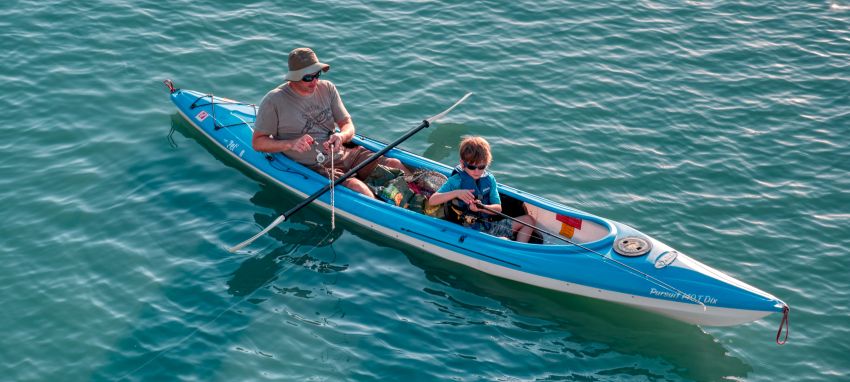
As we saw above, sit-on-top kayaks make a better platform from which to hunt and fish. Thanks to their high primary stability (on flat, calm water), they are steady enough that you can stand, shift positions, cast out a fishing line, even fire your gun without having to worry about tipping over. Though there are many sit-in kayaks designed for fishing, they’re not as versatile as sit-on-top kayaks, and may not be as comfortable for long, all-day fishing trips.
For hunting, both sit-on-top and sit-in kayaks can be customized with a hunting blind, removable seat, etc.
See our article on the best duck hunting kayaks to learn more…
Because the ocean tends to be both unpredictable and more turbulent by nature, you want a kayak with higher secondary stability (on rough, choppy waters). That, as you’ve learned by now, is a sit-in kayak. You sit lower in the water (below the water’s surface, in fact), and the low center of gravity prevents you from tipping over.
Plus, a sit-in kayak lets you use a spray skirt to protect yourself from freezing ocean water, and both the speed and steering/handling/tracking of sit-in kayaks is significantly better-suited to long-distance paddling.
Typically, you’ll find that the low-budget sit-on-top kayaks cost around 25-40% less than a sit-in kayak. Even as you get into the premium end of the spectrum—top-quality fishing or hunting sit-on-top kayaks or expedition sit-in kayaks—the price disparity tends to be about the same.
Sit-on-top kayaks are easier to make, require less precision in the design and fine-tuning of the details. Sit-in kayaks tend to be pricier because their design must be just right in order to be functional.
If you’re trying to keep costs low, the sit-on-top kayak is the better choice. However, cost is one of the least important factors to consider when kayak shopping—you want to find a vessel that suits your needs best first, then figure out how much to pay after you’ve found what serves your purposes.
